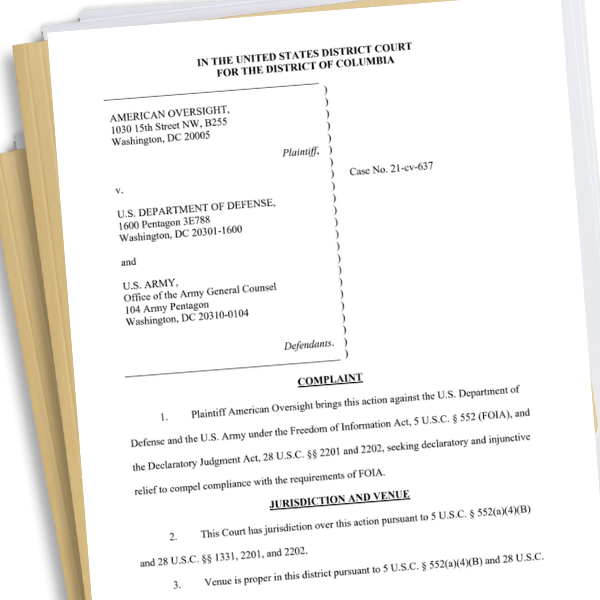
American Oversight Sues for Records About Trump’s Actions During Jan. 6 Attack
What role, if any, did the former president have in the delayed response to the Capitol riot? And how did the White House and other senior government officials respond to the attack he incited?

The American people still have questions about the role former President Donald Trump played during the deadly Jan. 6 attack on the U.S. Capitol. American Oversight is seeking answers this week through Freedom of Information Act lawsuits that could shed light on Trump’s activities that day, including his reported involvement in the troubling delay in deployment of the National Guard during the assault.
American Oversight submitted requests less than a week after the attack for records of communications between the Defense Department or the Army and Trump, his chief of staff Mark Meadows, or Vice President Mike Pence. Pence reportedly was the one to push to send in National Guard troops while the former president allegedly resisted such a move. We also submitted requests for the Jan. 6 call logs of top officials at the National Guard, the Pentagon, the Army, and the Department of Justice, which could help the public understand how the federal government responded to the mob attack.
On Wednesday, we filed two lawsuits in federal court to compel the release of these records. Both lawsuits follow another suit, filed Tuesday, that seeks records of communications and directives or orders sent or received by top officials on the day of the attack and during the preceding week.
Trump’s repeated lies about voter fraud and incitement of his supporters led to the violent attack, which temporarily disrupted Congress’ certification of the 2020 election results — and ultimately resulted in his second impeachment.
Trump spoke at the “Stop the Steal” rally outside the White House at around 1 p.m. on Jan. 6, telling supporters to “fight like hell” to take their “country back.” Armed and violent supporters overtook the Capitol within hours in a conflict that left five dead, including a Capitol Police officer.
At 2:24 p.m. — after being informed that Pence was being escorted from the Senate floor by security because of the mob — Trump tweeted that Pence “didn’t have the courage to do what should have been done to protect our Country and our Constitution.” During the attack, a makeshift gallows with a noose was set up outside the Capitol, and rioters in the building could be heard shouting, “Hang Mike Pence.”
Despite widespread news coverage of the mob ransacking the Capitol and attacking law enforcement, Trump waited nearly two hours to publicly call for his supporters to stand down — tweeting a video at 4:17 p.m. in which he again lied about the election and told the rioters, “Go home, we love you, you’re very special.”
Behind the scenes, Trump reportedly delayed sending in the National Guard to restore order on Capitol Hill. National Guard Maj. Gen. William Walker recently testified that he received a call from the head of Capitol Police at 1:49 p.m. about the security breach, with a request for immediate assistance. But it wasn’t until 5:08 p.m. that he received approval to help take the Capitol back.
CNN reported the next day that it was Pence, not Trump, who eventually facilitated the National Guard deployment — raising significant questions about the chain of command during the crisis and what role, if any, Trump had in that delay of more than three hours.
The records sought in the lawsuits American Oversight filed today could give the public much-needed transparency into what actually happened on a dark day for our democracy — and how the White House reacted to an attack fomented by the then-president himself.
